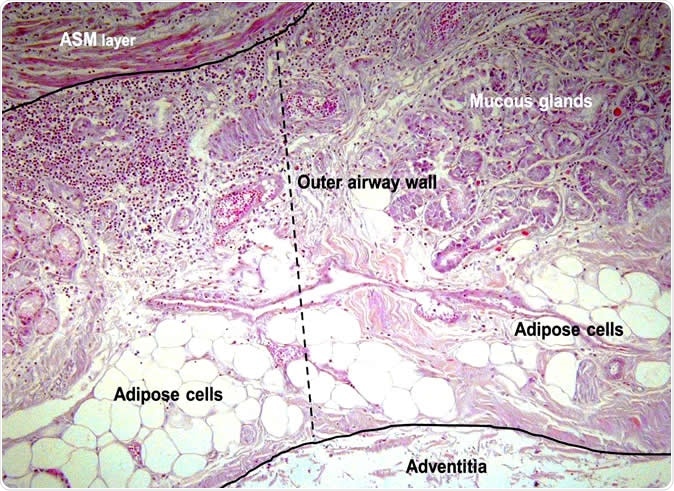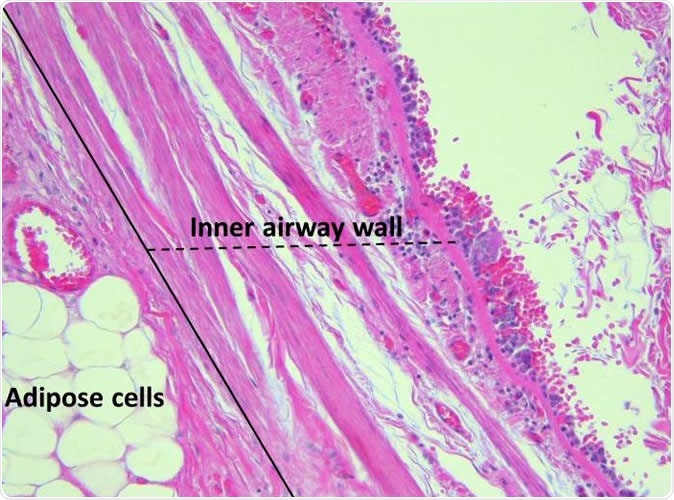Obesity is a growing health concern among children and adults across the globe. In the 2016 figures from the World Health Organization (WHO), 1.9 billion adults are overweight worldwide, and of these, over 650 million were obese.
Previously, it was known that overweight or obese individuals are more likely to have asthma and wheezing, but the exact reason has been unclear. The study, which was published in the European Respiratory Journal, shows that the accumulation of fatty tissue impairs the structure of the airways, hence, potentially leading to a higher risk of developing asthma.

Micrographs (x200) of the (A.) outer airway wall, between the airway smooth muscle (ASM) layer and the airway adventitia (dashed line) showing adipose tissue and mucous glands and (B.) inner airway wall (submucosa), between the basement membrane and ASM layer (dashed line) in a case of fatal asthma stained with haematoxylin and eosin. Inflammatory cells were counted within the inner airway wall. Image Credit: European Respiratory Journal
"Our research team studies the structure of the airways within our lungs and how these are altered in people with respiratory disease. Looking at samples of lung, we spotted fatty tissue that had built up in the airway walls. We wanted to see if this accumulation was correlated with body weight,” Mr. John Elliot, a senior research officer at Sir Charles Gairdner Hospital, said.

Micrographs (x200) of the (A.) outer airway wall, between the airway smooth muscle (ASM) layer and the airway adventitia (dashed line) showing adipose tissue and mucous glands and (B.) inner airway wall (submucosa), between the basement membrane and ASM layer (dashed line) in a case of fatal asthma stained with haematoxylin and eosin. Inflammatory cells were counted within the inner airway wall. Image Credit: European Respiratory Journal
Body mass index (BMI) and airway fat accumulation
The researchers examined samples of lung tissue from 52 individuals, including 15 people who reported to have asthma, 16 who had died of asthma, and 21 people who had asthma but died of other causes. The postmortem samples were from the Airway Tissue Biobank, which was donated for research purposes.
They examined more than 1,300 airways under a microscope and measured if there are fatty tissue present. Then, comparing the data they gathered with the body mass index (BMI), they found that in those who are overweight or obese, the more there is fatty tissue accumulation in the airway walls. This means that fatty tissue accumulation increases in relation to increasing BMI.
“These data show that adipose tissue is present within the airway wall and is related to BMI, wall thickness, and the number of inflammatory cells. The accumulation of airway adipose tissue in overweight individuals may, therefore, contribute to airway pathophysiology,” the researchers wrote in the study.
The researchers suggest that the fatty tissue buildup is tied to inflammation in the lungs, therefore, triggering asthma-like symptoms such as wheezing.
They also explain that in the past, obesity has been associated with having asthma, and past studies have suggested that the link might be explained by the direct pressure of excess weight on the lungs. Another reason is that people who are obese may have inflammation, which affects the lungs.
The new study reveals that there is more to asthma in overweight and obese people. Fat buildup in the airway walls may take up too much space and can trigger inflammation in the airways. Also, with fat accumulation in the airway walls, there is limited space for air to enter.
At present, the researchers want to confirm if there is indeed a connection between respiratory disease and obesity. They want to determine if these respiratory disorders linked to obesity can be reversed by weight loss.
The study also sheds light on the relationship between asthma and obesity. This way, health experts can develop new therapies that can target obesity in conjunction with respiratory therapy.
“If you struggle with your weight and have asthma, exercise is a great way to help manage your weight and can improve asthma symptoms such as coughing, wheezing and gasping for breath, which can lead to life-threatening asthma attacks,” Emma Rubach, head of health advice at Asthma UK, said.
“This is because getting active boosts your lung power and reduces breathlessness. It also supports the immune system and helps fight colds and viruses – a major trigger for 80 percent of people with asthma,” she added.
Journal reference:
Fatty Airways: Implications for Obstructive Disease John G. Elliot, Graham M. Donovan, Kimberley C.W. Wang, Francis H.Y. Green, Alan L. James, Peter B. Noble European Respiratory Journal Jan 2019, 1900857; DOI: 10.1183/13993003.00857-2019, https://erj.ersjournals.com/content/early/2019/09/02/13993003.00857-2019